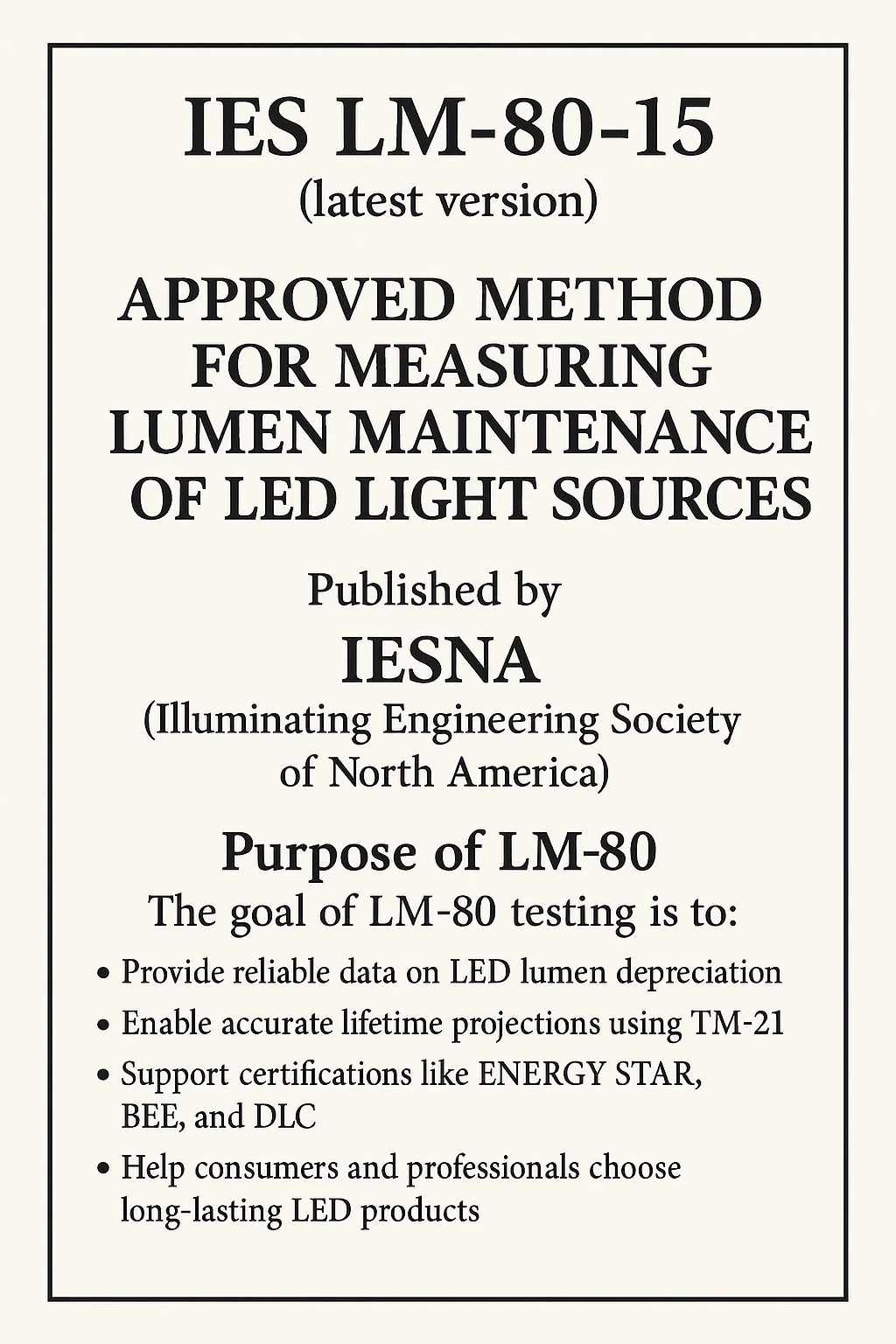LM-80
What is LM-80 Testing?
LM-80 is a test method developed by IES (Illuminating Engineering Society) to evaluate the lumen maintenance of LED light sources over time.
It helps determine how long an LED will retain its brightness under specific conditions.
Full Form
LM = Lumen Maintenance
80 = Assigned test number by IES (not the duration or rating)
Purpose of LM-80
- To measure how LEDs perform over time in terms of brightness.
- Helps manufacturers, designers, and certifying bodies ensure product longevity.
- LM-80 data is used for ENERGY STAR, BIS-BEE, and Lighting Design certifications.
Who Requires LM-80 Testing?
-
LED Chip/Package Manufacturers: To prove the durability and reliability of their LEDs.
-
Lighting Product Manufacturers: To use the LM-80 data in their TM-21 calculations (which predict the useful lifetime of the final product).
-
BEE Star Label & International Standards: LM-80 data is often required for BEE Star Label registration and ENERGY STAR certifications.
What Does LM-80 Measure?
1. Lumen Maintenance (L70, L80, L90): How much luminous flux (light output) is maintained after a specific number of hours.
o L70 = 70% of initial lumens retained
o L80 = 80% retained
o L90 = 90% retained
2. Chromaticity Shift (Color Stability): Checks if the LED changes
Products Covered
- LED Packages
- LED Arrays
- LED Modules
Note: LM-80 does not test entire fixtures – only the LED components.
Testing Conditions
Duration: Minimum of 6,000 hours, preferably 10,000 hours
- Ambient temperatures: 55°C, 85°C, or both
- Drive current: Same as actual application or higher
- Measurement frequency: Every 1,000 hours
- Chambers used: Controlled thermal and electrical testing environments
Key Test Outputs
- Light output degradation curve
- Chromaticity shift report
- Thermal performance
- Reported values at different operating points
LM-80 Testing in India
Required for BIS-CRS, BEE, and MNRE certifications
Accepted by government agencies for energy efficiency compliance

LM-80 vs. LM-79 — What’s the Difference?
| Parameter | LM-80 | LM-79 |
|---|---|---|
| What is tested? | LED chips/packages/modules only | Complete LED luminaire or lamp |
| Purpose | Long-term lumen & color maintenance | Photometric & electrical performance |
| Duration | Minimum 6,000 hours | Few days to a week |
| Who uses the report? | LED chip suppliers & fixture makers | Fixture/product manufacturers & importers |

Frequently Asked Questions (FAQs) – LM-80 Testing
Q1. What is LM-80 testing?
A: LM-80 is a test method defined by the Illuminating Engineering Society (IES) to measure the lumen maintenance and color stability of LED light sources, arrays, or modules over time. It tells you how much light your LED will maintain after continuous use.
Q2. What products need LM-80 testing?
A: LM-80 applies to LED packages, LED arrays, and LED modules — not to complete luminaires or lamps. Final products require LM-79 testing instead.
Q3. How long does LM-80 testing take?
A: An LM-80 test runs for a minimum of 6,000 hours (about 8-9 months) and may extend up to 10,000 hours (about 14-15 months) to generate reliable lifetime data.
Q4. Is LM-80 mandatory for BIS or BEE Star Label?
A: For energy-efficient LED products, LM-80 test reports (along with TM-21 projection) are often required to demonstrate the durability of LED chips. Many BEE Star Label and ENERGY STAR programs make LM-80 reports mandatory for compliance.
Q5. What is the difference between LM-79 and LM-80?
A: LM-79 tests the photometric and electrical performance of a complete LED lamp or luminaire, while LM-80 tests the LED light source only for lumen and color maintenance over time.
Q6. What is TM-21 and how is it related to LM-80?
A: TM-21 is a method that uses LM-80 data to calculate the projected lifetime of the LED light source. LM-80 gives real data, and TM-21 predicts how long the LEDs will maintain performance.
Q7. Does Bharati Global Compliances help with LM-80?
A: Yes! We verify your supplier’s LM-80 reports, assist with TM-21 lifetime projections, and ensure you have the right documents for BIS, BEE Star Label, and other global approvals.
Q8. Who should get LM-80 tested — the chip maker or product manufacturer?
A: Typically, LED chip manufacturers perform LM-80 testing in accredited labs. Product manufacturers use that data to support the performance claims of their final product.
Q9. What documents do I need for LM-80 compliance?
A: An accredited LM-80 report, TM-21 calculation report, the LED datasheet, and your product’s design details showing how the LED chips are used.
Q10. How can I get started with LM-80 for my products?
A: Contact Bharati Global Compliances! We’ll check your supplier’s reports, coordinate with labs if needed, and help you prepare a compliant file for any energy efficiency or BIS approval process.
How Bharati Global Compliances Helps You
✔ Verifying authentic LM-80 reports from your LED suppliers
✔ Coordinating with BIS/BEE-recognized labs if new testing is required
✔ Preparing TM-21 life projection calculations
✔ Submitting the correct documents for BIS, BEE Star Label, or global certifications
✔ Ensuring you meet all durability and performance claims for your LED products